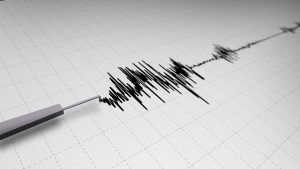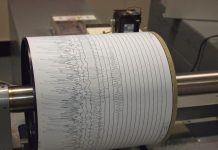
An international team led by geologist Michael Strasser has used novel methods to analyze sediment deposits in the Japan Trench in order to gain new insights into the carbon cycle.
In a paper recently published in Nature Communications, geologist Michael Strasser presented the initial findings of a month-long research expedition off the coast of Japan. The research initiative had been organised in March 2012 by MARUM – Center for Marine Environmental Sciences. Strasser, who until 2015 was Assistant Professor for Sediment Dynamics at ETH Zurich and is now a Full Professor for Sediment Geology at the University of Innsbruck, took an international team there to study dynamic sediment remobilisation processes triggered by seismic activity.
At a depth of 7,542 metres below sea level, the team took a core sample from the Japan Trench, an 800-km-long oceanic trench in the northwestern part of the Pacific Ocean. The trench, which is seismically active, was the epicentre of the Tohoku earthquake in 2011, which made headlines when it caused the nuclear meltdown at Fukushima. Such earthquakes wash enormous amounts of organic matter from the shallows down into deeper waters. The resulting sediment layers can thus be used later to glean information about the history of earthquakes and the carbon cycle in the deep ocean.
New dating methods in the deep ocean
The current study provided the researchers with a breakthrough. They analysed the carbon-rich sediments using radiocarbon dating. This method – measuring the amount of organic carbon as well as radioactive carbon (14C) in mineralised compounds – has long been a means of determining the age of individual sediment layers. Until now, however, it has not been possible to analyse samples from deeper than 5,000 metres below the surface, because the mineralised compounds dissolve under increased water pressure.
Strasser and his team therefore had to use new methods for their analysis. One of these was what is known as the online gas radiocarbon method, developed by ETH doctoral student Rui Bao and the Biogeoscience Group at ETH Zurich. This greatly increases efficiency, since it takes just a single core sample to make more than one hundred 14C age measurements directly on the organic matter contained within the sediment.
In addition, the researchers applied the Ramped PyrOx measurement method (pyrolysis) for the first time in the dating of deep-ocean sediment layers. This was done in cooperation with the Woods Hole Oceanographic Institute (U.S.), which developed the method. The process involves burning organic matter at different temperatures. Because older organic matter contains stronger chemical bonds, it requires higher temperatures to burn. What makes this method novel is that the relative age variation of the individual temperature fractions between two samples very precisely distinguishes the age difference between sediment levels in the deep sea.
Dating earthquakes to increase forecast accuracy
Thanks to these two innovative methods, the researchers could determine the relative age of organic matter in individual sediment layers with a high degree of precision. The core sample they tested contained older organic matter in three places, as well as higher rates of carbon export to the deep ocean. These places correspond to three historically documented yet hitherto imprecisely dated seismic events in the Japan Trench: the Tohoku earthquake in 2011, an unnamed earthquake in 1454, and the Sanriku earthquake in 869.
At the moment, Strasser is working on a large-scale geological map of the origin and frequency of sediments in deep-ocean trenches. To do so, he is analysing multiple core samples taken during a follow-up expedition to the Japan Trench in 2016. “The identification and dating of tectonically triggered sediment deposits is also important for future forecasts about the likelihood of earthquakes,” Strasser says. “With our new methods, we can predict the recurrence of earthquakes with much more accuracy.”
Reference:
Rui Bao et al, Tectonically-triggered sediment and carbon export to the Hadal zone, Nature Communications (2018). DOI: 10.1038/s41467-017-02504-1
Note: The above post is reprinted from materials provided by ETH Zurich.










